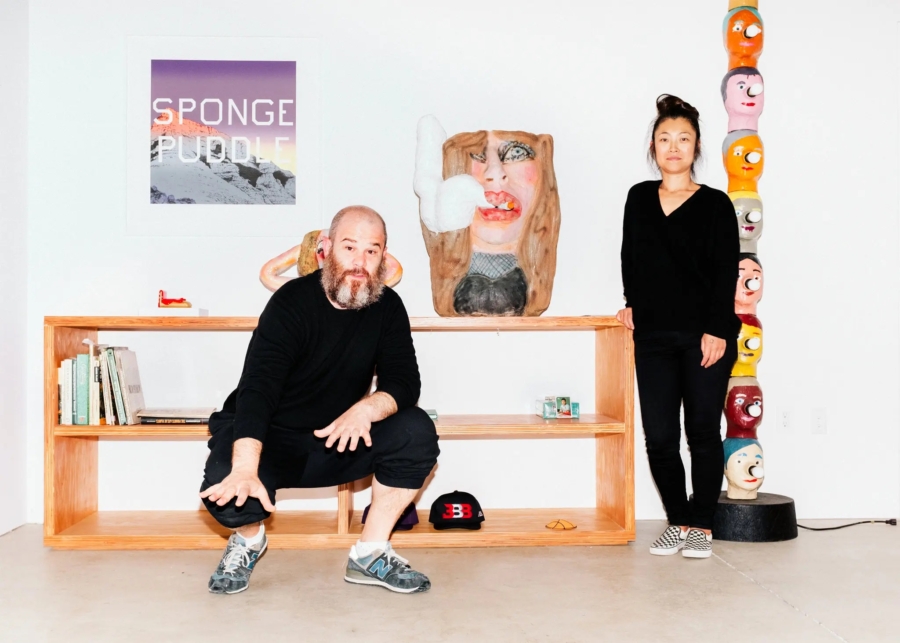May 29, 2018
Download as PDF
View on The New York Times

Inside their sprawling/spraying studio, Jonas Wood and Shio Kusaka, husband and wife artists, display works from their private collection. Here, they posed before works by Ed Ruscha (left), Ron Nagle (below the Ruscha print), Ruby Neri (center) and Evan Holloway (right). Credit Coley Brown for The New York Times
LOS ANGELES — Where Koreatown and Silver Lake meet Historic Filipinotown — beyond a construction site and a tent city and behind a thick metal gate — lies a Shangri-La, the 22,000-square-foot studio of the husband and wife artists Jonas Wood and Shio Kusaka.
Mr. Wood, 41, a Massachusetts-born painter known for bucolic David Hockneyesque still-life interiors and abstract depictions of sport, and Ms. Kusaka, 46, a Japanese master of porcelain ceramics, bought this space a year ago.
Inside, they have dedicated most of the space to their extensive art collection, including nearly three dozen ceramic pieces by Magdalena Suarez Frimkess and Michael Frimkess. There is also room for personal studios and offices studded with their own work.
Wild-bearded and wild-eyed, Mr. Wood is unabashed in his love for collecting. Speedwalking through the complex, with the couple’s spaniel-mix, Robot, trotting behind, Mr. Wood stops on a dime and points out a signed Larry Bird jersey hanging from a lofty ceiling. “I’m a huge N.B.A. fan,” he explains.
The gym features “Untitled (portrait)” a Richard Prince Instagram photo and a suggestive print of Paris Hilton by the Norwegian photographer Torbjorn Rodland among the free weights and machines. The bathroom has an Andy Warhol sketch alongside comic-book work from Raymond Pettibon and a print by Robert Heinecken.
With so many stimuli, it’s easy to miss details, like the green stalks sprouting from the floor.
There’s a loft with beds, couches and a TV for when work runs late, and toys to keep the couple’s two children happy. Screenprints from Ed Ruscha and Roy Lichtenstein frame the room, but it’s the hand-knotted silk Christopher Wool rug that ties it together, despite a painterly black stain that might give the Big Lebowski pause. Finishing the second-floor tour with a brief stop in a bedroom, we glimpse an erotic Picasso etching — like an Easter egg in a video game — before Mr. Wood switches off the light. Then he’s whizzing downstairs where a vintage poster and etched mirror of a chimpanzee poker dealer by Michael Wilkinson keeps company with a washer and dryer.
More downstairs pieces include Alex Israel’s silk-screen collage of the license plate from “Back to the Future,” a “Mountain Print” lithograph by Mr. Ruscha and ceramics by Ruby Neri, Ry Rocklen and Akio Takamori.
In a conference room, two works by Los Angeles-based artists face off: Will Boone’s acrylic “Jason Mask” and Calvin Marcus’s “Green Calvin,” a mushroom-tongued ceramic devil on green hardboard. “It’s actually painted clay mounted on a painting,” Mr. Wood explains.
These are edited excerpts from the conversation.
What are some of your favorite pieces?
JONAS WOOD We’re really into the Frimkesses, who are Los Angeles ceramists. He threw these vessels, the ones on the top shelf, and she painted them. I’ve made drawings of paintings out of their pots and included them in larger still-life paintings.
And their work is similar to your own process?
WOOD We don’t really collaborate, but we both include each other’s work in our work. More an appropriation, a shared imagery. What’s interesting, too, about this couple is that they also appropriated their practice for these works in particular. Michael, the husband, chose these based on historical vessels.
SHIO KUSAKA She had this whole book set that somebody gave her — the history of Japanese pottery.
WOOD In pottery a lot of times people make up their own shape, but he’s mimicking a form from an ancient vessel.
KUSAKA And she paints.
WOOD She paints from postcards she finds. So it’s pretty similar to both of our practices, because I work from photographs or postcards; she works based on thrown vessels, much like Michael.
KUSAKA Because I have the same book, I know those images.
And there’s playful stuff on the ceramics: Betty Boop, Popeye, Minnie Mouse.
WOOD Yeah, all appropriations. And over here we’ve got Mark Grotjahn, Joe Bradley, this is a Peter Saul painting, and that’s a Boetti canvas.
Tell me about the weed growing out of the floor.
WOOD This is Tony Matelli, an artist from New York. If you remember on the High Line, there was a sculpture of a sleepwalking man. That’s this guy. We just thought this would look cool here, because it looks like it just broke out of the ground because this is how dandelions would grow in nature.



